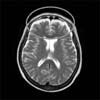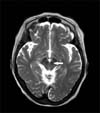Abstract
Toluene is one of well-known neuro-toxicants. It can readily cross the blood-brain-barrier and mainly affect the central nervous system (CNS). An inhalation is the typical route of its human exposure and show a variety of symptoms involving cerebral and cerebellar dysfunction, bronchial asthma, chemical pneumonitis, toxic hepatitis, renal tubular acidosis, intestinal obstruction, and myelo-dysplastic syndrome. In this case, toluene-inhalated showed numerous CNS and systemic symptoms. Authors performed such gait analysis, gross and fine motor evaluations, computerized neurocognitive test that we noticed the impaired results. After comprehensive rehabilitation for four weeks, patient improved as much as she could carry out the independent life, and finally discharged home. Authors report the case of toluene-induced encephalopathy in Republic of Korea for the first time.
Figures and Tables
 | Fig. 1Both frontal lobes mild cortial atrophy (grey circle) on axial T2-weighted MR image of the brain. |
References
1. Slivia LC, Maria TRG, John JW. Review of toluene action: clinical evidence, animal studies and molecular targets. J Drug Alcohol Res. 2014; 3:DOI: 10.4303/jdar/235840.
2. Malaguarnera G, Cataudella E, Giordano M, Nunnari G, Chisari G, Malaguarnera M. Toxic hepatitis in occupational exposure to solvents. World J Gastroenterol. 2012; 18(22):2756–2766.
3. Nakajima T, Wang RS. Induction of cytochrome P450 by toluene. Int J Biochem. 1994; 26(12):1333–1340.
4. Shadnia S, Ahmadimansesh M, Ghazi KM, Zamani N. Intestinal obstruction in acute inhalational toluene 2,4-diisocyanate gas toxicity. Int J Occup Environ Med. 2013; 4(3):164–166.
5. Jung KH, Chu K, Kim YA, Jeon BS. Rapidly progressive toxic leukoencephalomyelopathy with myelodysplastic syndrome: a clinicopathological correlation. J Clin Neurol. 2007; 3(1):45–49.
6. Ramcharan K, Ramesar A, Ramdath M, Teelucksingh J, Gosein M. Encephalopathy and neuropathy due to glue, paint thinner, and gasoline sniffing in Trinidad and Tobago-MRI findings. Case Rep Neurol Med. 2014; 850109. DOI: 10.1155/2014/850109.
7. Suzuki K, Wakayama Y, Takada H, Okayasu H. A case of chronic toluene intoxication with abnormal MRI findings: abnormal intensity areas in cerebral white matter, basal ganglia, internal capsule, brain stem and middle cerevellar peduncle. Rinsho Shinkeigaku. 1992; 32(1):84–87.
8. Echeverria D, Fine L, Langolf G, Schork T, Sampaio C. Acute behavioural comparisons of toluene and ethanol in human subjects. Br J Ind Med. 1991; 48:750–761.
9. Yucel M, Takagi M, Walterfang M, lubman DI. Toluene misuse and long-term harms: a systematic review of the neuropsychological and neuroimaging literature. Neurosci Biobehav Rev. 2008; 32(5):910–926.
10. Deleu D, Hanssens Y. Cerebellar dysfunction in chronic toluene abuse: beneficial response to amantadine hydrochloride. J Toxicol Clin Toxicol. 2000; 38:37–34.
11. Fuente A, McPherson B. Organic solvents and hearing loss: The challenge for audiology. Int J Audiol. 2006; 45(7):367–381.
12. So YT. Current occupational and environmental medicine. Neurotoxicology. 2007; 2:373–383.




 PDF
PDF ePub
ePub Citation
Citation Print
Print




 XML Download
XML Download